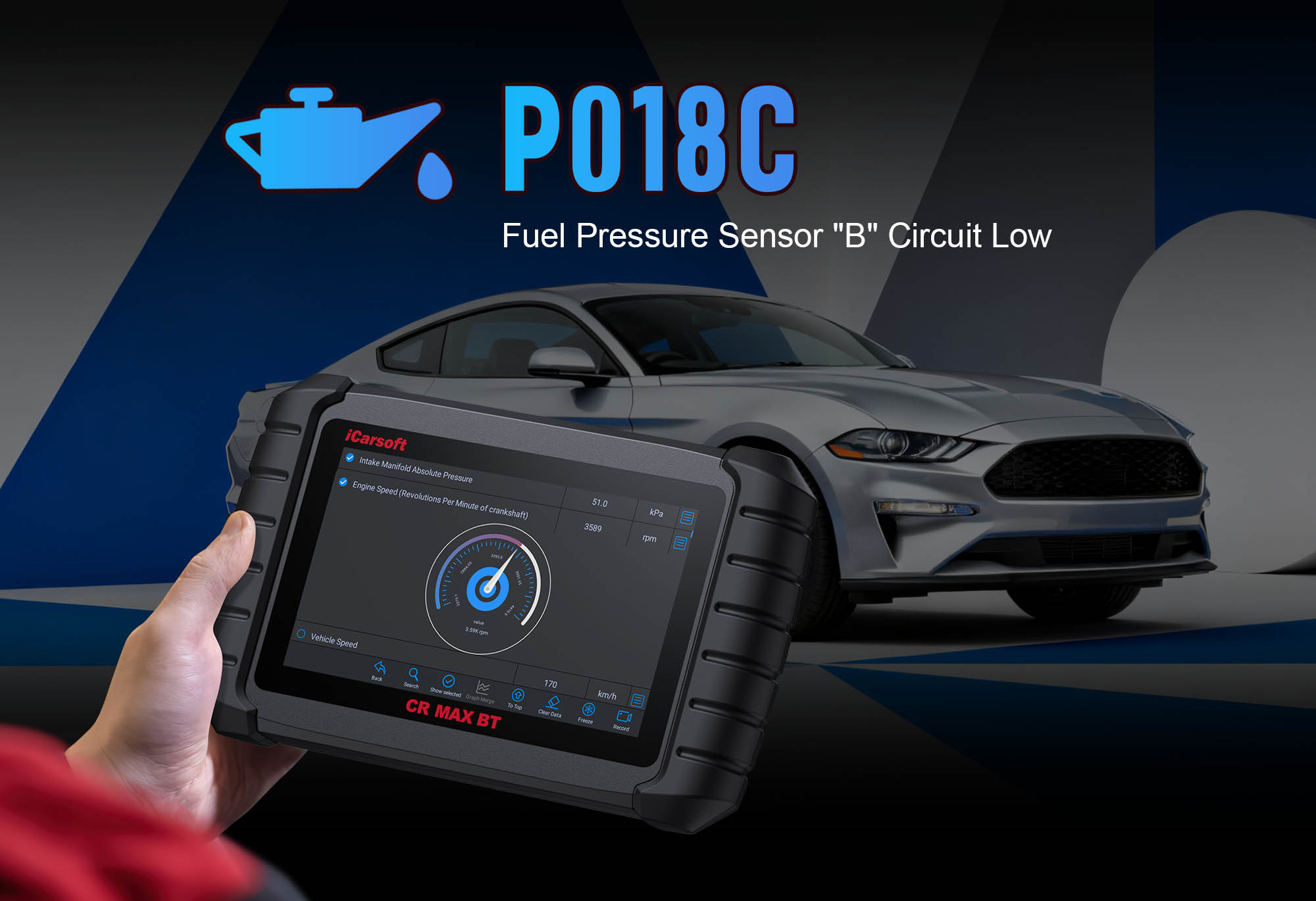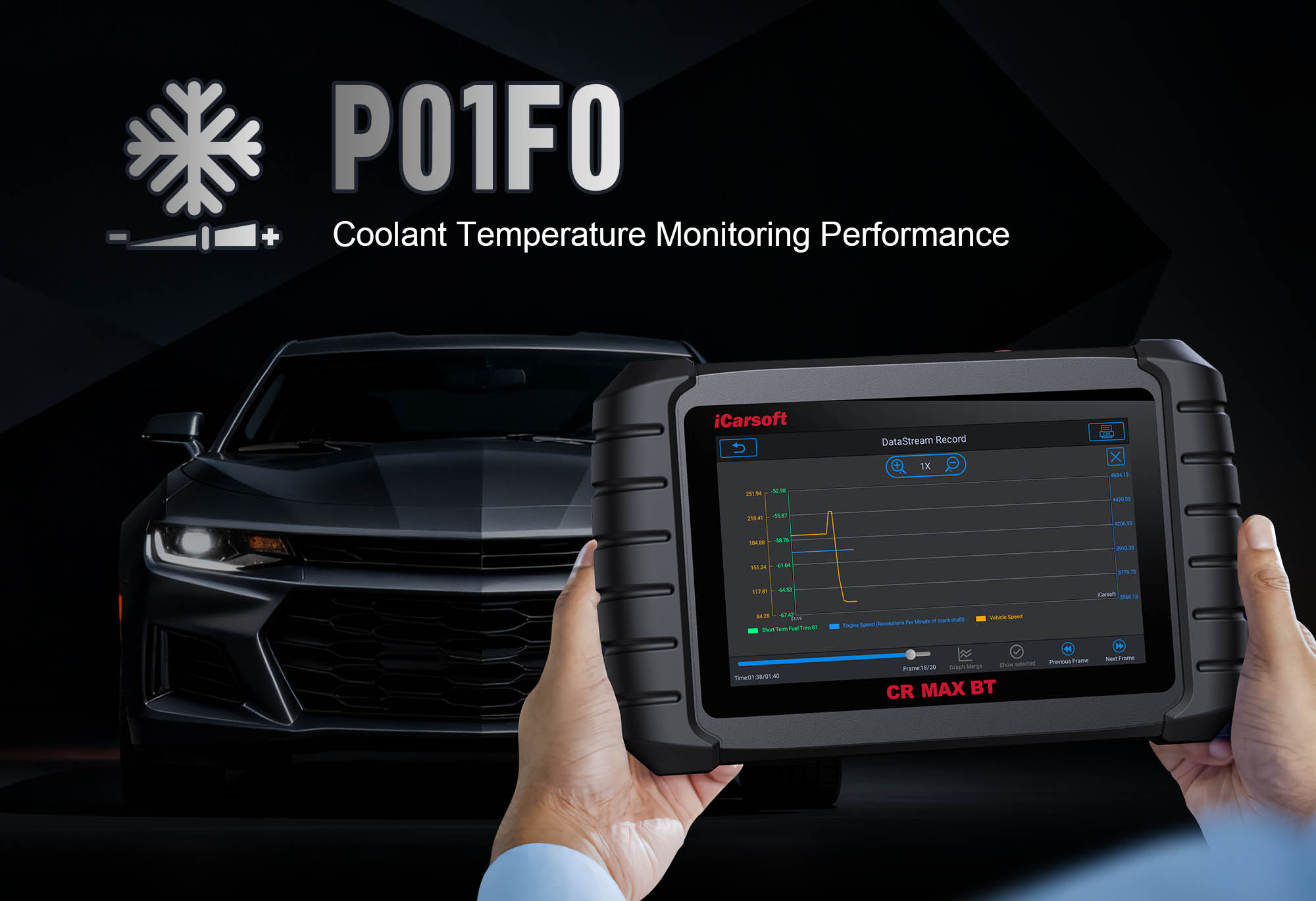Understand & Fix P018C: Fuel Temperature Sensor B Circuit Range/Performance with iCarsoft CR MAX BT
If your vehicle’s Check Engine Light (CEL) stays lit, fuel efficiency drops unexpectedly, or you notice inconsistent performance in extreme temperatures, a diagnostic scan may return P018C. This critical OBD-II code stands for "Fuel Temperature Sensor B Circuit Range/Performance"—a fault targeting the secondary fuel temperature sensor (Sensor B), which works with the primary sensor (Sensor A) to provide redundant fuel temperature data to the Engine Control Module (ECM). When Sensor B’s signal falls outside the normal range (-40°F to 302°F / -40°C to 150°C), the ECM logs P018C to prevent engine damage, poor fuel economy, and emissions non-compliance.
Basic scanners might only label this a "sensor error," but they can’t distinguish between a faulty Sensor B, damaged wiring, or an ECM communication glitch. This ambiguity often leads to unnecessary sensor replacements (costing $180–$350) when the issue is a $40 wiring repair. The iCarsoft CR MAX BT eliminates guesswork with wireless OE-level diagnostics, bidirectional testing, and 58-brand coverage—making it the ideal tool for fixing P018C in popular vehicles like the Ford F-150, Chevrolet Silverado, and Toyota Tundra. Below, we break down P018C’s causes, symptoms, step-by-step fixes, and 8 FAQs to resolve the issue confidently.
What Exactly Is P018C?
P018C specifically targets the Fuel Temperature Sensor B—the secondary sensor responsible for verifying fuel temperature readings from Sensor A. It’s typically located in the fuel rail, tank, or fuel line, depending on the vehicle make/model. This sensor sends voltage signals to the ECM (0.5V–4.5V); when signals are erratic (e.g., sudden spikes/drops) or stay outside the normal range, the ECM flags a "range/performance" fault.
This code is prevalent in vehicles with dual fuel temperature sensors (common in modern trucks and luxury cars), such as the Ford F-150 P018C sensor B and Chevrolet Silverado P018C wiring fault. It’s also common in vehicles exposed to frequent temperature fluctuations, where sensor components wear faster.
Key Symptoms of P018C
-
Illuminated Check Engine Light: The primary alert, often paired with a "Fuel Temp Sensor B Circuit Fault" message in newer models (critical for 2021+ Toyota Tundra P018C CEL).
-
Reduced Fuel Efficiency: A faulty Sensor B causes the ECM to use a "safe" fuel map, leading to 8–15% higher fuel consumption (prevalent in high-mileage P018C vehicles).
-
Inconsistent Cold-Start Performance: Without accurate secondary temperature data, the engine may struggle to start in cold weather (e.g., Ford F-150 P018C cold start).
-
Engine Hesitation or Stalling: Erratic fuel temperature data disrupts combustion, causing the engine to lag during acceleration or stall at idle (common in Chevrolet Silverado P018C hesitation).
-
Increased Emissions: Incorrect fuel injection raises hydrocarbon levels, leading to failed smog checks (key for California P018C emissions test).
Common Causes of P018C
|
Cause
|
Description
|
|
Faulty Fuel Temperature Sensor B
|
Internal component damage (from fuel contamination or heat) stops accurate signal transmission—top cause in Ford F-150 P018C sensor failure.
|
|
Wiring/Connector Issues
|
Frayed wires, corroded terminals, or loose connectors break the sensor’s signal path—common in Chevrolet Silverado P018C wiring damage (exposed to fuel system moisture).
|
|
Fuel Contamination
|
Dirty or watered-down fuel damages the sensor’s element—critical for diesel truck P018C fuel quality (e.g., Toyota Tundra).
|
|
ECM Communication Glitch
|
Poor communication between Sensor B and the ECM triggers false codes—fixable via the CR MAX BT’s ECM Reset function.
|
|
Sensor A Failure
|
A faulty primary sensor (Sensor A) can cause Sensor B to register abnormal readings—use the CR MAX BT to test both sensors simultaneously.
|
Why iCarsoft CR MAX BT Excels at Diagnosing P018C
Resolving P018C requires precise dual-sensor and fuel system testing—something basic scanners can’t do. The CR MAX BT stands out with exclusive features tailored to this fault:
Wireless Bluetooth Diagnostics
Test from 30+ feet away—no tangled cables, perfect for accessing hard-to-reach Sensor B (e.g., under Ford F-150 truck beds).
Dual-Sensor Data Comparison
Monitors real-time readings from Sensor A and Sensor B—spots discrepancies (e.g., 150°F vs. 50°F) in seconds.
Bidirectional Control
Sends commands to activate Sensor B, eliminating false codes from unresponsiveness (top P018C cause).
58-Brand Vehicle Coverage
Works with all P018C-prone makes: Ford F-150, Chevrolet Silverado, Mercedes-Benz, BMW, and more.
CAN-FD Protocol Compatibility
Supports 2018+ modern vehicles with faster data transmission, ensuring accurate diagnostics for new-model P018C cases.
7-Inch Touchscreen
Easy-to-navigate interface for switching between live data, fault codes, and fuel system tests—ideal for DIYers and pros.
Step-by-Step: Diagnose & Fix P018C with iCarsoft CR MAX BT
-
Confirm P018C & Gather Vehicle-Specific Data
Plug the CR MAX BT’s OBD-II adapter into the vehicle port and connect via Bluetooth (pair with 7-inch touchscreen quickly).
Select AutoVIN Identify to detect make/model/Sensor B location (e.g., fuel rail for Chevrolet Silverado).
Navigate to Engine > Fault Codes > Read Codes to confirm P018C. Tap Code Details for insights (e.g., "Ford F-150: Voltage 0.2V; Check Sensor/Wiring").
-
Analyze Live Dual-Sensor Data
Go to Engine > Live Data > Fuel System to monitor three key metrics:
1. Sensor B Temperature: Matches Sensor A’s reading (±5°F)—extreme deviations = Sensor B fault.
2. Sensor B Voltage: Stays 0.5V–4.5V—0V/5V = no signal (wiring/sensor issue).
3. Fuel Rail Pressure: Within OEM specs (30–50 psi for gas engines)—deviations = pressure-related P018C.
-
Test Sensor B & Wiring with Bidirectional Control
1. Use Bidirectional Test to send "Sensor Calibration" command to Sensor B—temperature/voltage doesn’t adjust = faulty sensor.
2. Locate Sensor B via Component Location tool, disconnect connector. Use Resistance Test (OEM specs 10–15 ohms at room temp)—infinite resistance = faulty sensor.
3. Wiring Test: Use Continuity Test for breaks between Sensor B and ECM—repair with heat-shrink tubing or replace harness.
-
Repair & Validate the Fix
1. Replace faulty Sensor B/wiring, or clean contaminated fuel (use Fuel Quality Test to spot issues). Update ECM firmware via One-Key Upgrade (lifetime free Wi-Fi updates) for glitches.
2. Run Fuel Sensor Reset to sync Sensor B to ECM. Clear P018C via Fault Codes > Clear Codes, test drive 50 miles.
3. Re-scan with CR MAX BT—matching readings from Sensor A and Sensor B = issue resolved.
FAQs: Your P018C Questions Answered
Can I drive with P018C, or will it damage my vehicle?
Short trips (to a repair shop) are safe, but prolonged driving risks fuel system damage and reduced efficiency. Avoid heavy loads—critical for Ford F-150 P018C towing scenarios.
How much does it cost to fix P018C?
Fuel Temperature Sensor B replacement = $180–$350 (parts + labor), wiring repairs = $40–$120. The CR MAX BT saves $100+ on diagnostics and avoids unnecessary sensor swaps.
Why does P018C keep coming back after sensor replacement?
Hidden issues like fuel contamination P018C or faulty Sensor A are likely. Use the CR MAX BT’s fuel quality test and dual-sensor comparison to rule out these causes.
Is P018C the same as P018B (Fuel Temperature Sensor A)?
No—P018C = Sensor B (secondary); P018B = Sensor A (primary). The CR MAX BT’s code details clarify differences with location guides.
Can bad fuel cause P018C?
Yes—dirty or watered-down fuel damages Sensor B’s element. For bad fuel P018C fix, drain and replace fuel, then retest with the CR MAX BT.
Does the CR MAX BT work for diesel vehicles (e.g., Toyota Tundra) with P018C?
Yes—supports diesel models with diesel-specific fuel tests, ensuring accurate diagnostics for high-pressure fuel system P018C cases.
Will P018C fail emissions tests?
Yes—incorrect fuel injection raises emissions. Fix P018C with the CR MAX BT to pass California P018C smog checks.
How often should I update the CR MAX BT’s software for P018C fixes?
Lifetime free Wi-Fi updates (one-click via touchscreen) ensure compatibility with new vehicles—update every 3 months to handle 2024+ model P018C cases.
Conclusion
P018C’s secondary fuel temperature sensor issues may seem complex, but the iCarsoft CR MAX BT simplifies diagnostics with wireless convenience, dual-sensor testing, and 58-brand coverage. Whether you’re fixing a faulty Sensor B in a Ford F-150 or wiring in a Chevrolet Silverado, this tool saves time, money, and frustration.
Don’t let P018C reduce fuel efficiency or damage your fuel system. Invest in the CR MAX BT today and take control of your vehicle’s performance.




